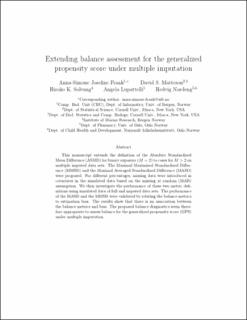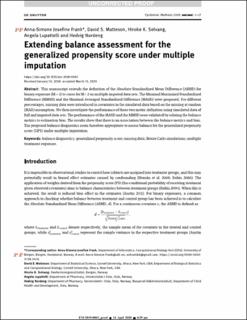| dc.contributor.author | Frank, Anna-Simone | |
| dc.contributor.author | Matteson, David S. | |
| dc.contributor.author | Solvang, Hiroko Kato | |
| dc.contributor.author | Lupattelli, Angela | |
| dc.contributor.author | Nordeng, Hedvig Marie Egeland | |
| dc.date.accessioned | 2021-09-10T08:50:45Z | |
| dc.date.available | 2021-09-10T08:50:45Z | |
| dc.date.created | 2020-06-07T14:58:57Z | |
| dc.date.issued | 2020 | |
| dc.identifier.citation | Epidemiologic Methods. 2020, 9 (1), . | |
| dc.identifier.issn | 2194-9263 | |
| dc.identifier.uri | https://hdl.handle.net/11250/2775155 | |
| dc.description.abstract | This manuscript extends the definition of the Absolute Standardized Mean Difference (ASMD) for binary exposure (M = 2) to cases for M > 2 on multiple imputed data sets. The Maximal Maximized Standardized Difference (MMSD) and the Maximal Averaged Standardized Difference (MASD) were proposed. For different percentages, missing data were introduced in covariates in the simulated data based on the missing at random (MAR) assumption. We then investigate the performance of these two metric definitions using simulated data of full and imputed data sets. The performance of the MASD and the MMSD were validated by relating the balance metrics to estimation bias. The results show that there is an association between the balance metrics and bias. The proposed balance diagnostics seem therefore appropriate to assess balance for the generalized propensity score (GPS) under multiple imputation. | |
| dc.language.iso | eng | |
| dc.title | Extending balance assessment for the generalized propensity score under multiple imputation | |
| dc.type | Peer reviewed | |
| dc.type | Journal article | |
| dc.description.version | acceptedVersion | |
| dc.description.version | acceptedVersion | |
| dc.source.pagenumber | 17 | |
| dc.source.volume | 9 | |
| dc.source.journal | Epidemiologic Methods | |
| dc.source.issue | 1 | |
| dc.identifier.doi | 10.1515/em-2019-0003 | |
| dc.identifier.cristin | 1814222 | |
| cristin.ispublished | true | |
| cristin.fulltext | postprint | |
| cristin.fulltext | postprint | |
| cristin.qualitycode | 1 | |

